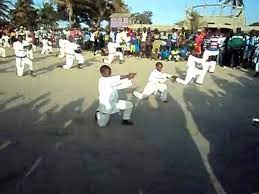By Kumba Leigh
Martial arts are codified systems and traditions of combat practiced for a number of reasons such as self-defense; military and law enforcement applications; competition; physical, mental, and spiritual development; entertainment; and the preservation of a nation’s intangible cultural heritage (Wikipedia).
Although not as popular as other sporting and traditional physical techniques or exercises, ‘Karate’ is fairly commonly known in The Gambia. Few centres and organizations are promoting the art and they are gaining popularity.
In what was regarded as the first in The Gambia, fourteen clubs across the country recently took part in a Karate competition held in Old Yumdum Primary School.
A total of forty gold, silver and bronze medals, along with trophies and certificates were presented to winners.
Speaking in an interview, Mr Ebrahim Sanneh, Secretary General of WAZA United Karate Club underscored the significance of martial arts and the need to expose the youth to it.
He narrated that WAZA was established on the 29th May 2004 by three of their great masters; namely Sanseh Ebrahim Jallow, Modou Sallah, and Abdoulie Touray. He described them as renowned fighters who had brought lot of achievements by promoting self-defence, and discipline among the youth.
‘‘Since the establishment of the club, we have trained many people some of whom are now working with the Police Intervention Unit, the army and other security institutions in The Gambia. We trained both male and female, as well as children at the age of seven”.
Sanneh further noted the value of ‘Karate’ in one’s physical, mental and spiritual being; saying it makes one healthy, enhances confidence, and self-control.
He reveled that at times their students are mobilised to do patrols to amplify efforts of the security personnel. He said they have been taught how to defend against weapons like knife, or even a dangerous attack.
Explaining the ranks and the colors that represent the qualifications, the Executive Secretary said the white belt represents a starter, yellow shows understanding is in progress, orange is rapid improvement, green signifies that basic steps of karate have been successfully accomplished, blue is level ahead, purple is advance stage, brown is skills getting mature, red is a dangerous student while the black belt explains certification of clear understanding and expert in the domain,” he said.
For Pateh Jobe, president of WAZA Karate Club, all sports are important; he thus called on philanthropists, government and private sectors’ actors to come to their aid. He pointed out that such a sporting activity is costly and requires assistance to ensure its sustainability.
Martial Arts:
According to Paul Bowman, the term martial arts was popularized by mainstream popular culture during the 1960s to 1970s, notably by Hong Kong Martial Arts Films (most famously those of Bruce Lee) during the so-called “chopsocky” wave of the early 1970s.
For John Clements, the term martial arts itself is derived from an older Latin term meaning “arts of Mars”, the Roman god of war, and was used to refer to the combat systems of Europe (European martial arts) as early as the 1550s.
The term martial science, or martial sciences, was commonly used to refer to the fighting arts of East Asia (Asian martial arts) up until the 1970s, while the term Chinese boxing was also used to refer to Chinese martial arts up until then.
Some authors have argued that fighting arts or fighting systems would be more appropriate terms on the basis that many martial arts were never “martial” in the sense of being used or created by professional warriors.

